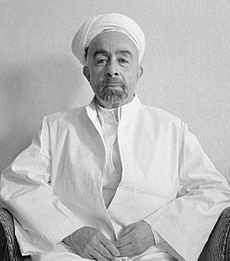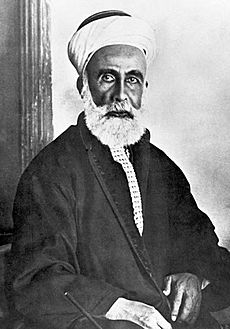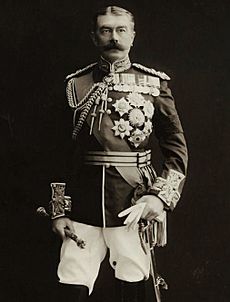Damascus Protocol facts for kids
The Damascus Protocol was an important document given to Faisal bin Hussein in May 1915. It came from two secret Arab groups called al-Fatat and Al-'Ahd. Faisal received it during a trip to Damascus, where he was meeting with Turkish officials.
These secret groups promised to support Faisal's father, Hussein bin Ali, in a rebellion against the Ottoman Empire. This support depended on certain demands being given to the British. These demands described the land for a new, independent Arab state in the Middle East. This area would cover all the Ottoman lands in Western Asia south of the 37th parallel north. These demands later became the main ideas behind the Arab understanding of the Hussein–McMahon Correspondence, which were letters between Arab and British leaders.
Contents
What the Protocol Said
The Damascus Protocol listed the main things the Arabs wanted. It was first translated into English in 1938 by George Antonius. Here are the key demands:
- Independence: Great Britain had to agree that Arab countries were independent. These countries would be within specific borders:
- North: From Mersin-Adana up to the 37th parallel north, then along a line through Birejek-Urga-Mardin-Midiat-Jazirat (Ibn 'Unear)-Amadia to the border of Persia.
- East: The Persian border down to the Persian Gulf.
- South: The Indian Ocean (but the city of Aden would stay under its current rule).
- West: The Red Sea and the Mediterranean Sea back to Mersin.
- End of Special Privileges: All special rights given to foreigners, known as "capitulations," would be removed.
- Alliance: A defense agreement would be made between Great Britain and the future independent Arab State.
- Economic Preference: Great Britain would be given special economic benefits.
Why the Protocol Was Created
The Damascus Protocol came about because of growing tensions and secret talks during World War I.
Early Talks with Britain
In February 1914, Abdullah, a son of the Sharif (a respected leader in Mecca), met with Herbert Kitchener, a British official in Egypt. Abdullah wanted to know if Britain would help his father, Hussein, if the Turks made moves against the Hejaz region. At first, Kitchener couldn't promise anything.
However, a few months later, Abdullah met with Kitchener's secretary and was told that Britain would protect the current situation in Arabia from "unprovoked Turkish attacks."

When World War I started in August 1914, Britain's view changed. Kitchener, now a top war official, asked Abdullah if the Arabs would support Britain if Turkey joined the war on Germany's side. Abdullah replied that the Sharif would help Britain if Britain supported them against the Turks.
By October, Turkey had joined Germany. Kitchener then promised that if the Arab leaders and the "Arab Nation" helped Britain in the war, the British would recognize and support their independence. He also said Britain would protect Arabia from outside attacks. Kitchener even added that an Arab leader might become the new Caliph (a religious and political leader) in Mecca or Medina.
Hussein didn't mention the Caliphate in his reply. He said he couldn't immediately break with the Turks because of his important religious position in Islam.
Turkey's Call for Holy War
On November 11, 1914, the Turks declared a jihad (a holy war) against the Allied powers. They asked Arab leaders, including Husayn bin Ali, to support this call and send troops.
In January 1915, Hussein was approached by Fauzi al-Bakri, whose brother was a member of the secret group Al-Fatat. Fauzi wanted to convince the Sharif to lead a revolt against the Ottomans. At the same time, Hussein's oldest son, Ali bin Hussein, found out about a Turkish plan to remove the Sharif from power.
Hussein then sent his son Faisal to confront the Grand Vizier (a high-ranking official) in Constantinople with proof of this plot. But Faisal was also told to stop in Damascus first. There, he was to talk with the leaders of the secret societies to see if a revolt was possible. He did this on March 26, 1915.
After a month of talks, Faisal wasn't sure the Arab movement was strong enough. He thought a revolt wouldn't work without help from one of the Great Powers (like Britain). When he reached Constantinople in April, he learned that the Turks really wanted an Arab declaration of jihad. This made Faisal worried about his family's position in the Hejaz.
On his way back, Faisal visited Damascus again. He continued his talks with al-Fatat and Al-'Ahd and decided to join their revolutionary movement. It was during this visit that he was given the document that became known as the 'Damascus Protocol'. This document stated that the Arabs would revolt alongside Great Britain if Britain recognized Arab independence. The independent area would stretch from the 37th parallel north (the southern border of Turkey) to Persia and the Persian Gulf in the east, the Mediterranean Sea in the west, and the Arabian Sea in the south.
Meeting at Ta'if
After discussions at Ta'if in June 1915, Hussein and his sons talked about the revolt. Faisal suggested being careful, Ali was against the rebellion, and Abdullah wanted to act. The Sharif then set a possible date for the armed revolt for June 1916. He also started talking with the British High Commissioner in Egypt, Sir Henry McMahon, through a series of letters known as the Hussein-McMahon Correspondence.
Images for kids
-
Abdullah I bin al-Hussein, King of Jordan (1949–1951) was born in Mecca, Ottoman Empire (currently Saudi Arabia)






